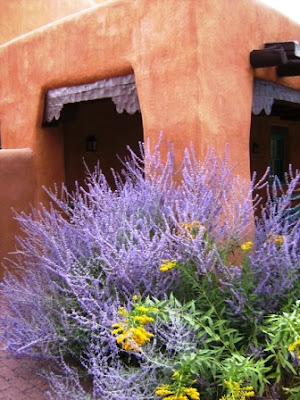
This photo was taken a couple of weeks ago; a reflection of the beautiful blue Colorado sky in the
water pot of my entry garden.
That pot is now empty and stored away until next spring. Now that we are well into the second month of fall, it’s time to get serious about preparing the garden for winter. Here is a check list of chores that I try to get done between late October and late November before the distractions of the holidays and the onset of really cold weather.
1. Plant bulbs.
2. Blow out automatic sprinkler system and insulate tap.
3. Remove hoses from faucets; drain. Store hoses and sprinklers in a handy location for winter watering.
4. Winterize water features. Drain, clean and store or cover fountains and pots. Remove plant debris from ponds and set up a bubbler (a submersible pump with a short piece of pipe attached to the outlet) to keep some surface area free of ice. Disconnect pumps to recirculating waterfalls---especially if the water volume is fairly low. Ice buildup can divert water and cause problems. Moving water will also make your pond colder, which may be an issue if you have fish.
5. Empty all containers of annual flowers or veggies (off to the compost pile!). Remove soil – or the top 8-10” from large pots - (again, off to the compost pile!), and put containers into storage. My “storage” is the back corner of my covered patio. A shed or garage would also do the trick. I have also had luck leaving large, glazed pots turned upside down right out in the garden.
6. Spread compost and/or slow release, organic fertilizer throughout planting beds.
7. Remove leaves from lawn areas. I rake my leaves directly into my garden beds for a loose, temporary mulch. I’ll remove them in the spring for composting. You can also run your lawn mower over them and leave them, or rake them up for mulch or to compost.
8. Winterize lawn mower. After the last mowing, run it until the gas tank is empty. Clean mower and sharpen blade.
9. Wrap young trees. I don’t need to do this anymore, but here are the
directions for “how-to”.
10. Clean up/cut back perennials. I do most of this in the spring, because I like the structure and texture that many plants offer during dormancy. However, it’s nice to have some puttering around to do on those days when I really want to be in the garden!
I’ve already completed a few of these items, but today I’m off to tackle #5. Enjoy your fall garden!


























































